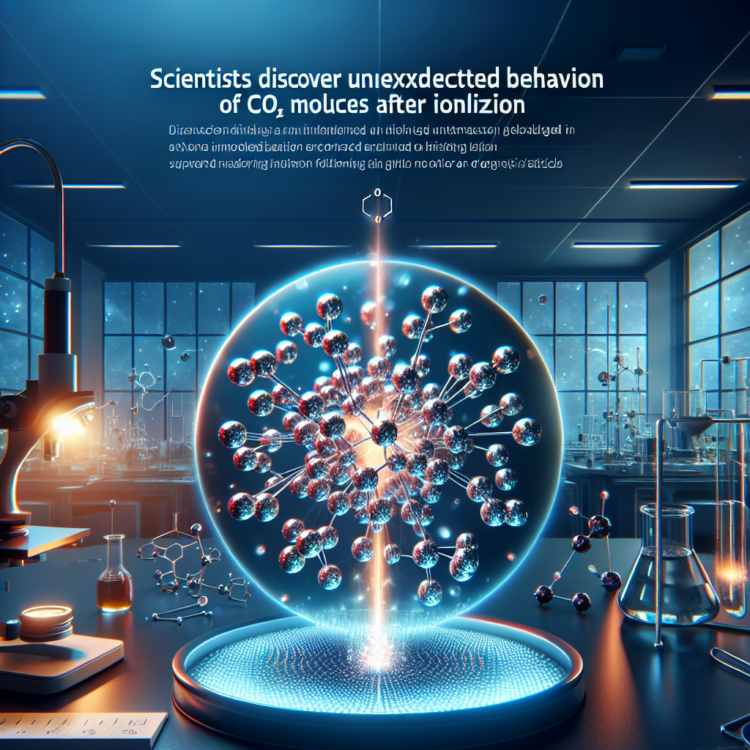A team of international scientists has unveiled a surprising discovery in molecular physics, revealing unexpected symmetry-breaking dynamics in ionized carbon dioxide dimers. Published in Nature Communications, the study provides new insights into the structural changes that occur when these molecular clusters are exposed to extreme ultraviolet (EUV) radiation.
A team of international scientists has unveiled a surprising discovery in molecular physics, revealing unexpected symmetry-breaking dynamics in ionized carbon dioxide dimers. Published in Nature Communications, the study provides new insights into the structural changes that occur when these molecular clusters are exposed to extreme ultraviolet (EUV) radiation.
An international team of scientists, led by Profs. Daniel Strasser and Roi Baer from The Hebrew University of Jerusalem, has made an important discovery in molecular physics, revealing unexpected symmetry-breaking dynamics in ionized carbon dioxide dimers. Published in Nature Communications, this study uncovers new insights into the structural changes that occur when these molecular clusters are exposed to extreme ultraviolet (EUV) radiation. The collaborative effort has demonstrated that ionized CO₂ dimers undergo asymmetric structural rearrangements, leading to the formation of CO₃ moieties. The discovery has significant implications for atmospheric and astrochemistry, offering a deeper understanding of molecular behavior under extreme conditions.
Key Findings: Symmetry-Breaking Dynamics and Structural Rearrangement
In environments such as cold outer space and atmospheric settings, carbon dioxide molecules often form symmetrically shaped pairs. According to quantum mechanics, the wave function of these pairs should preserve symmetry even after ionization. However, researchers from The Hebrew University of Jerusalem (Israel), the Max Planck Institute for Nuclear Physics (Germany), and the FLASH free electron laser facility at DESY (Germany) have observed a phenomenon called symmetry-breaking.
Two well-established quantum chemistry models were used to predict the behavior of the ionized dimers. The first model suggested that the molecules would move in unison, maintaining their symmetrical shape. In contrast, the second model predicted that ionization would break the symmetry, causing one of the molecules to slowly rotate around its axis and point toward its partner within approximately 150 femtoseconds. Through the use of ultrafast EUV pulses produced by the FLASH free electron laser, the researchers confirmed the second model, showing that the ionized dimers indeed undergo asymmetric structural rearrangement.
This symmetry-breaking leads to the formation of CO3 moieties, which could play a crucial role in the chemical evolution of more complex species in cold outer space environments.
Quantum Mechanics and the Symmetry-Breaking Phenomenon
A key question arising from this study is how symmetry-breaking occurs despite quantum mechanics forbidding it. The researchers explain that, similar to Schrödinger’s famous cat, the pair of carbon dioxide molecules exists in a superposition of two symmetry-breaking states. The system preserves symmetry until the quantum wave function collapses upon measurement, resulting in one of the CO2 molecules rotating relative to the other.
Broader Implications and Future Research
Prof. Daniel Strasser, the study’s lead author, highlighted the significance of the findings: “Our research demonstrates the power of combining cutting-edge experimental techniques with advanced theoretical modeling to uncover unexpected molecular behavior. These insights into the dynamics of ionized carbon dioxide dimers could open new avenues for carbon dioxide chemistry and contribute to our understanding of planetary and atmospheric processes.”
Prof. Roi Baer, who led the theoretical modeling, commented: “By directly comparing theory with experimental measurements, we improve our ability to simulate and predict the outcome of chemical reactions that occur in remote environments and are not possible to experimentally test in a laboratory.
The study’s results have significant implications for atmospheric chemistry, astrochemistry, and provides new insights about the atmospheric carbon dioxide cycle. The discovery of asymmetric structural rearrangements, formation of a CO3 moiety, and time-resolved dynamics provides a deeper understanding of molecular processes in extreme conditions.
This research was made possible through international collaboration and the use of state-of-the-art facilities, including the FLASH2 free electron laser at DESY in Hamburg, Germany. The team’s innovative approach paves the way for further investigations into the behavior of molecular clusters under extreme conditions, with potential applications ranging from atmospheric science to novel chemical synthesis methods.
Credit: Authors
Clip: Movie shows simulated CO2 dimer dynamics that are initiated by photoionization. The kinetic energy release (KER) in the Coulomb explosion of the dimer by a time-delayed pulse allowed to experimentally probe the dynamics.
Journal
Nature Communications
Method of Research
Experimental study
Subject of Research
Not applicable
Article Title
Symmetry-breaking dynamics of a photoionized carbon dioxide dimer
Article Publication Date
27-Jul-2024




